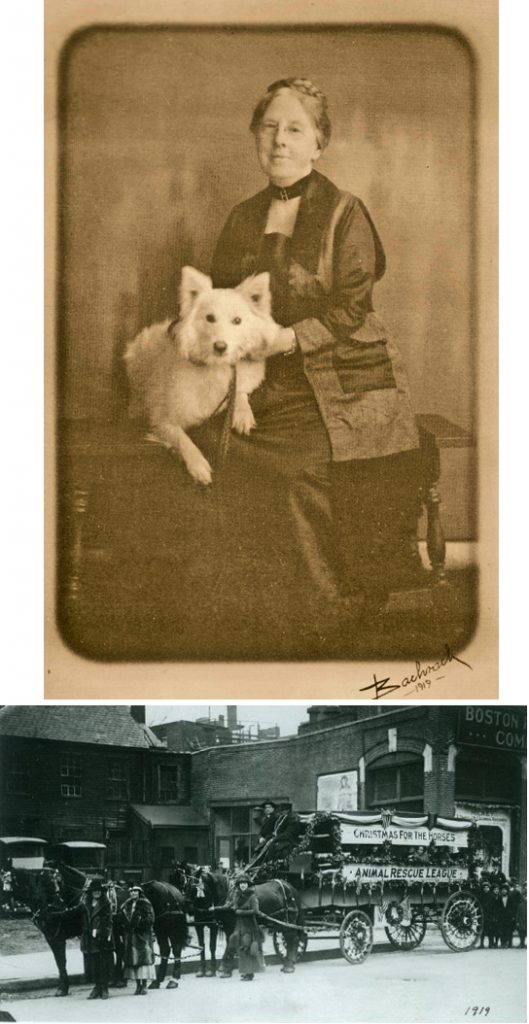
Dorchester Illustration no. 2481 Anna Harris Smith
Founder of the Animal Rescue League
Nearly everyone in Dorchester has heard of or used the services of The Animal Rescue League. But few of us realize that it was founded by a Dorchester woman.
Anna Harris Smith (1843-1929) was born at 65 Pleasant Street, at the foot of Jones Hill, the house she lived in until 1908. A large section of Jones Hill had been owned by the Clapp family almost since the founding of Dorchester in 1630. Anna Harris was the grand-daughter of Samuel Clapp, who had a modest cooperage business. Her mother Anna Larkin Clapp married William Harris, a Boston printer. Anna, the subject of this piece, married Huntington Smith, a publisher. Anna’s occupation was journalist in the 1900 US Census. A founder of the League in 1899, she served as president of the Animal Rescue League from 1901 until her death in 1929, and the League flourished under her leadership.
The following is from an article by Anthony Sammarco that appeared in the Dorchester Community News, ca. 1990.
The young Anna Harris, imbued with family connections and born to a world of comfort, was christened at the First Parish Church by her paternal grandfather. As a child, she was intelligent and developed both a flair for music and a deep abiding feeling for animals and nature. It was said that her father was a strict and religious man and that these values, instilled in his daughter, gave a deep spiritual devotion to her great cause of later years.
Anna Harris completed her education in Boston, after attending Miss Pope’s School on Meeting house Hill. She became an accomplished musician, and taught music, giving informal recitals with her brother Samuel who was a talented violinist. She also composed music for several songs. The Harris family, comfortable and well-established, were among the leaders of local society.
In 1884, Anna Harris married Huntington Smith of Boston; he was the editor of the Boston Beacon, later to become its owner and publisher. The Smiths lived in Anna’s family home, which had been built on the stone foundations of the Thomas Jones House, reputedly built in 1636.
The Clapps had purchased the original house from Jones’ heirs and rebuilt it after a disastrous fire in 1804. The five-bay Federal house, while not pretentious, was surrounded by lands that were not just extensive, but valuable. The Smiths subdivided their estate over the years into house lots.
Undoubtedly, Anna Smith was a compassionate person, and tried to do the right thing concerning animals. But according to her biography, she was deeply shocked when a neighbor told her that, when her cat became too old to catch mice, she would have it taken to the woods and left there. This apparently fueled Smith’s desire to form some sort of protective circle for animals.
As a member of the First Parish Church’s Benevolent Society, then headed by Emily Fifield, Smith visited the sick and the poor. Apart from the human misery that she saw, she was overwhelmed by the conditions of animals in back alleys and beasts of burden on the main streets of Boston. This concern became a driving force for Smith, and culminated with the incorporation of the Animal Rescue League of Boston on March 13, 1899.
Smith coined the phrase “Kindness Uplifts the World,” which is still the league’s motto. Throughout her long life, she had a great concern for all animals that she was able to combine with practical means to reduce suffering. True, her wealth and position enabled her to devote her activities to better the conditions of animals, but it was her never-ending sense of duty that sustained her when it became her life work.
Today, the rescue league takes in stray animals, most of which it spays and neuters, and tries to find them homes. In addition, the statewide group runs educational programs which teach children how to properly care for animals and has work crews which will pick up dead animals or rescue those who are caught in trees, for example.
The following is from Yankee Magazine.
The photo above was taken in 1919, and featured a horse-drawn carriage, decked out in holiday garland with banners titled “Animal Rescue League” and “Christmas for the Horses.” The caption underneath explained that it was the sixth annual Christmas dinner for horses, when members of the League would travel throughout the city, delivering “meals of oats, carrots, and apples to the working horses of Boston.”
Anna Harris Smith loved all animals, but had a special soft spot for horses. It’s easy to forget how important urban work horses were in the days before the automobile, but in the late 19th century and early 20th century, horses were critical in the day-to-day workings of all US cities. These “draft horses” not only transported all manner of goods within the city and to and from railroad stations, but also facilitated both public and private transportation and emergency services, such as ambulances and fire trucks…before they were trucks.
Anna and the ARL of Boston believed that these horses deserved treats at Christmas just like the rest of us, so the “Christmas Dinner for Horses” campaign was born, and continued into the 21st century. As recently as 2009, the League still delivered holiday goodies to the rapidly shrinking number of working horses within the city, made even smaller that year by the loss of the Boston Police Department’s 12-member mounted police patrol due to lack of funding.
